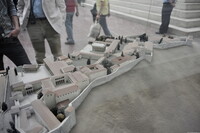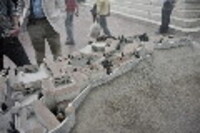| dc.coverage.spatial | Site: Pergamon Museum (Berlin, Berlin (state), Germany) | en_US |
| dc.coverage.temporal | before 2004 (creation) | en_US |
| dc.creator | unknown (German model maker) | en_US |
| dc.date | 1950-2004 | en_US |
| dc.date.accessioned | 2013-10-17T20:35:41Z | |
| dc.date.available | 2013-10-17T20:35:41Z | |
| dc.date.issued | 1950-2004 | en_US |
| dc.identifier | 238932 | en_US |
| dc.identifier.other | archrefid: 2693 | en_US |
| dc.identifier.uri | http://hdl.handle.net/1721.3/146701 | |
| dc.description | The spur of the acropolis on the highest part of the hill (height 355 m), the military barracks at the tip to the right (viewed from the back of the model); Pergamon was an ancient Greek city in Asia Minor (now Bergama, Turkey), later part of the Roman Empire. Pergamon (Gr.: "fort" or "stronghold") occupies a steep-sided hill (height 355 m). In Hellenistic times it was ruled by the Attalid dynasty (282-133 BCE), following the death of Alexander the Great. The summit of the hill of Pergamon forms the acropolis proper, with its own massive fortifications. The model shows the Acropolis (the upper city) as it was in the 2nd century CE (under Roman rule). Source: Wikipedia; http://en.wikipedia.org/wiki/Main_Page (accessed 8/1/2012) | en_US |
| dc.format.medium | wood; plaster; paint | en_US |
| dc.rights | © Scott Gilchrist, Archivision, Inc. | en_US |
| dc.subject | architecture | en_US |
| dc.subject | cityscape | en_US |
| dc.subject | City planning | en_US |
| dc.subject | models (representations) | en_US |
| dc.subject | Roman Empire | en_US |
| dc.subject | Greek Empire | en_US |
| dc.subject | Twentieth century | en_US |
| dc.title | Pergamon Acropolis Model | en_US |
| dc.type | image | en_US |
| dc.rights.access | Licensed for educational and research use by the MIT community only | en_US |
| dc.identifier.vendorcode | 7A3-G-PM-PM-BB13 | en_US |
| vra.culturalContext | German | en_US |
| vra.technique | construction (assembling) | en_US |
| vra.worktype | model (representation) | en_US |
| dc.contributor.display | unknown (German model maker) | en_US |


